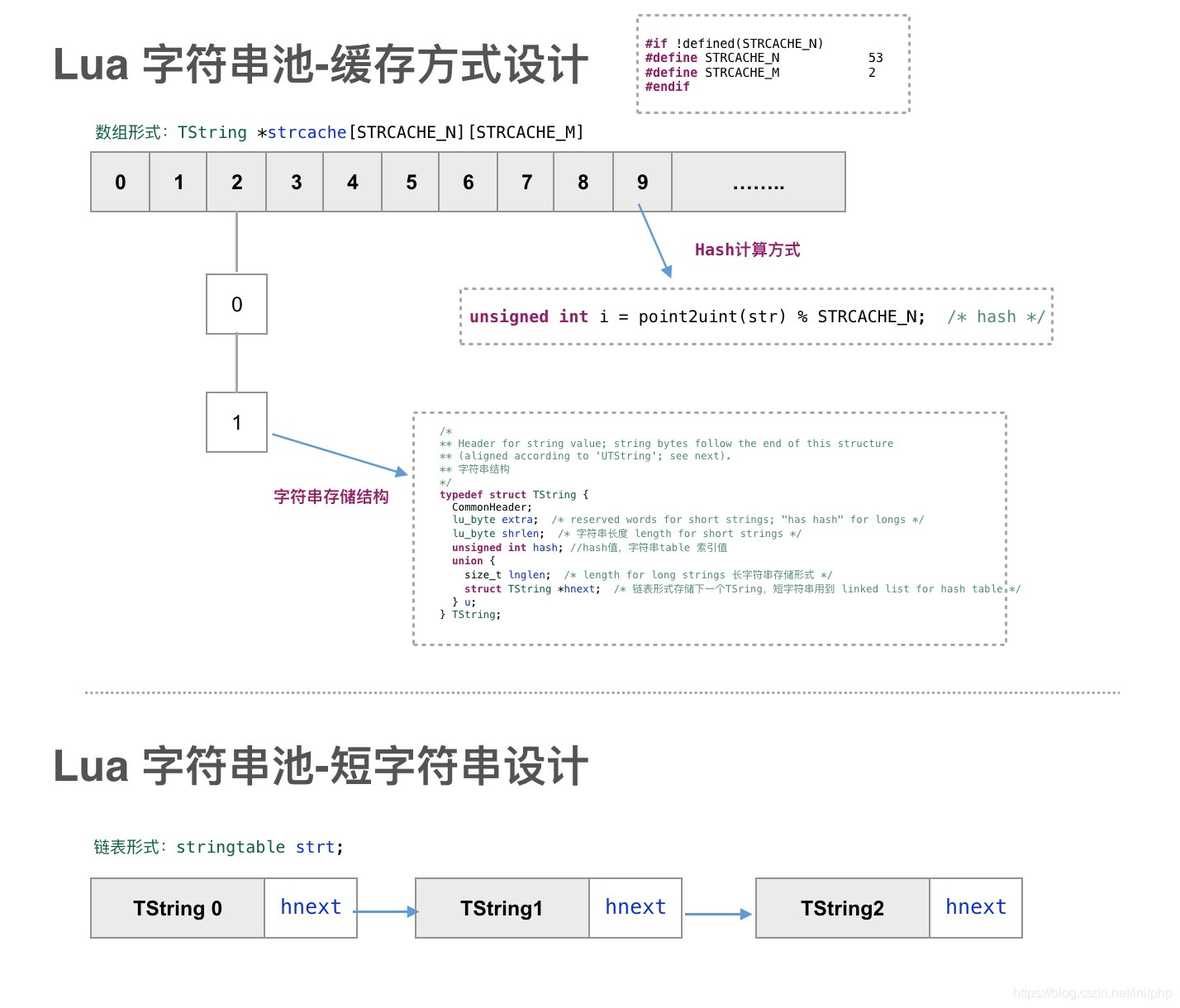|
|
目录
一、字符串 - 数据结构
二、字符串 - 初始化luaS_init
三、字符串 - 创建一个字符串luaS_new
四、字符串 - 清除缓存luaS_clearcache
前面两章我们讲解了Lua的整个栈操作。本篇文章开始,我们重点阅读一下Lua的几个重要数据结构:字符串、内存操作、对象操作等。
字符串操作对应的文件:lstring.c
一、字符串 - 数据结构
Lua的字符串管理都会统一挂载到global_State全局状态机上。
字符串都会存储在TString对象结构上。Lua的字符串管理分两种类型:链表方式存储(短字符串(<40)) 和 HashMap 缓存方式
链表方式:存储在stringtable strt; 链表结构上
缓存方式:存储在TString *strcache[STRCACHE_N][STRCACHE_M] HashMap的结构上。
PS:这里有一个点没看懂,当调用*luaS_new函数,字符串存储会走缓存方式;当单独调用luaS_newlstr函数,短字符串会统一管理,但是长字符串就没有统一地方管理。这块还没太明白
通过下面这个大图,可以一眼看清楚整个Lua的字符串管理方式。

/* 字符串管理 */
stringtable strt; /* 处理小于40的字符串,链表结构 - hash table for strings */
TString *strcache[STRCACHE_N][STRCACHE_M]; /* 字符串缓存,HashMap - cache for strings in API */
/*
** Header for string value; string bytes follow the end of this structure
** (aligned according to 'UTString'; see next).
** 字符串结构
*/
typedef struct TString {
CommonHeader;
lu_byte extra; /* reserved words for short strings; "has hash" for longs */
lu_byte shrlen; /* 字符串长度 length for short strings */
unsigned int hash; //hash值,字符串table 索引值
union {
size_t lnglen; /* length for long strings 长字符串存储形式 */
struct TString *hnext; /* 链表形式存储下一个TSring,短字符串用到 linked list for hash table */
} u;
} TString;
二维数组strcache的表索引,通过字符串hash值,并对桶做求余实现。
桶的默认值是:STRCACHE_N,默认53个桶
链表的默认长度:STRCACHE_M,默认2个元素
但是list长度是STRCACHE_M=2,list比较小,估计作者认为hash冲突的概率会非常小,同时每次都会将最早的元素element淘汰出去
unsigned int i = point2uint(str) % STRCACHE_N; /* hash */
二、字符串 - 初始化luaS_init
在全局状态机f_luaopen函数中,对字符串池进行了初始化。
初始化主要做两件事情:初始化链表、初始化缓存池
/*
** Initialize the string table and the string cache
** 初始化字符串链表和字符串缓存
*/
void luaS_init(lua_State *L) {
global_State *g = G(L);
int i, j;
luaS_resize(L, MINSTRTABSIZE); /* 默认大小128 字符串table initial size of string table */
/* pre-create memory-error message */
g->memerrmsg = luaS_newliteral(L, MEMERRMSG); //错误处理字符串
luaC_fix(L, obj2gco(g->memerrmsg)); /* it should never be collected */
for (i = 0; i < STRCACHE_N; i++) /* 缓存表中填充默认支付 fill cache with valid strings */
for (j = 0; j < STRCACHE_M; j++)
g->strcache[j] = g->memerrmsg;
}
三、字符串 - 创建一个字符串luaS_new
创建字符串函数有两个:luaS_new 和 luaS_newlstr
luaS_new:创建一个新的字符串,带缓存方式
luaS_newlstr:创建一个新的字符串,不带缓存
这里有一点没明白,如果调用了 luaS_newlstr,并且是长字符串,这种方式如何来管理和跟踪这个内存分配?因为两个函数遍历了整个代码,都会使用,有些地方走缓存,有些地方不走缓存。
/*
** new string (with explicit length)
** 创建一个存新的字符串,不带缓存
** 字符串不能超过最大限制
** 新的字符串会memcpy拷贝一个副本,挂载到TString结构上
*/
TString *luaS_newlstr(lua_State *L, const char *str, size_t l) {
if (l <= LUAI_MAXSHORTLEN) /* short string? 40字节 */
return internshrstr(L, str, l);
else {
TString *ts;
if (l >= (MAX_SIZE - sizeof(TString)) / sizeof(char))
luaM_toobig(L);
ts = luaS_createlngstrobj(L, l);
memcpy(getstr(ts), str, l * sizeof(char)); //内存拷贝副本
return ts;
}
}
/*
** Create or reuse a zero-terminated string, first checking in the
** cache (using the string address as a key). The cache can contain
** only zero-terminated strings, so it is safe to use 'strcmp' to
** check hits.
** 创建一个新的字符串,带缓存方式
** 会调用luaS_newlstr方法
** 1. 先通过字符串,获取字符串hash值
** 2. 通过hash值取字符串,如果相同的字符串已经存在,则复用
** 3. 否则创建一个新的字符串
**
** 字符串Table表,通过字符串的hash值找到list
** 但是list长度是STRCACHE_M=2,list比较小,估计作者认为hash冲突的概率会非常小
** 同时每次都会将最早的元素element淘汰出去
*/
TString *luaS_new(lua_State *L, const char *str) {
unsigned int i = point2uint(str) % STRCACHE_N; /* hash */
int j;
TString **p = G(L)->strcache;
for (j = 0; j < STRCACHE_M; j++) {
if (strcmp(str, getstr(p[j])) == 0) /* hit? */
return p[j]; /* that is it */
}
/* normal route */
for (j = STRCACHE_M - 1; j > 0; j--)
p[j] = p[j - 1]; /* move out last element */
/* new element is first in the list */
p[0] = luaS_newlstr(L, str, strlen(str));
return p[0];
}
四、字符串 - 清除缓存luaS_clearcache
/*
** Clear API string cache. (Entries cannot be empty, so fill them with
** a non-collectable string.)
** 清楚缓存
*/
void luaS_clearcache(global_State *g) {
int i, j;
for (i = 0; i < STRCACHE_N; i++)
for (j = 0; j < STRCACHE_M; j++) {
if (iswhite(g->strcache[j])) /* will entry be collected? */
g->strcache[j] = g->memerrmsg; /* replace it with something fixed */
}
}
————————————————
版权声明:本文为CSDN博主「老码农zhuli」的原创文章,遵循CC 4.0 BY-SA版权协议,转载请附上原文出处链接及本声明。
原文链接:https://blog.csdn.net/initphp/article/details/104126140
|
|